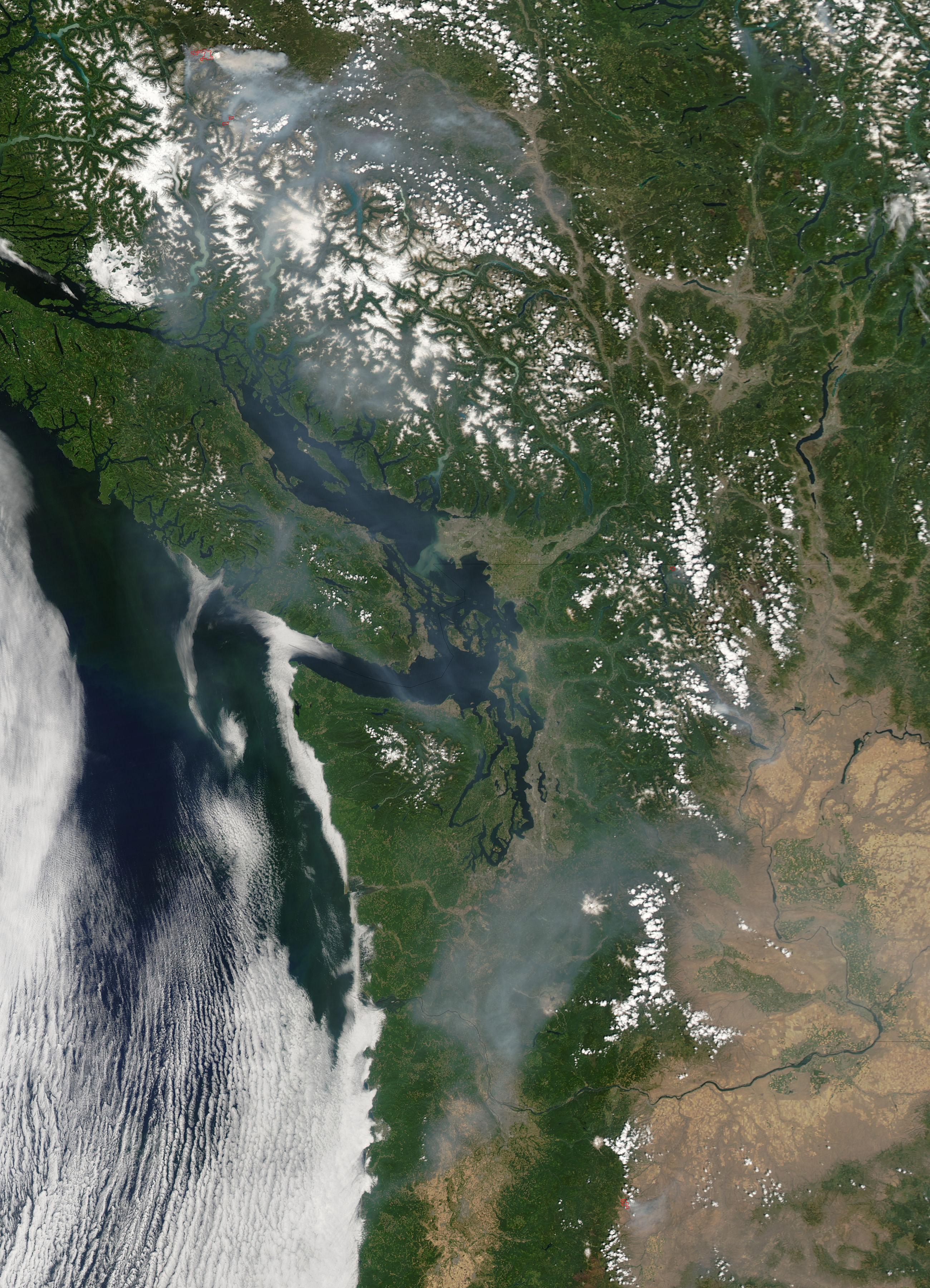

USA Today (2015, August 16) Northwest wildfires threaten dozens of communities.A recently published analysis of 35 years of meteorological data found that many parts of the West face longer wildfire seasons than they did a few decades ago, likely because of climate change. Many of the fires were triggered by lightning strikes, but years of drought have parched forests in the West and primed them to burn. Two of the most destructive blazes, the Canyon Creek Complex and Cornet–Windy Ridge fire had burned about 136,000 acres (55,000 hectares, or 200 square miles) and destroyed 47 structures as of August 17. The lower image shows the same fires on August 13.

Thick plumes of smoke drifted from the hot spots. Red outlines indicate hot spots where the sensor detected unusually warm surface temperatures generally associated with fires. The Moderate Resolution Imaging Spectroradiometer (MODIS) on NASA’s Aqua satellite collected this image of several fires burning in Idaho, Oregon, and Washington on August 16, 2015. While 73 percent of the burned area is the result of massive fires in remote forests in Alaska, large blazes have emerged in the Pacific Northwest as well. As of August 17, outbreaks of large wildfires had charred nearly 7 million acres, nearly two million more than the ten-year average through mid-August. If this becomes the case, it could aid the wildfire situation, and also the extreme drought for portions of the west.Summer usually brings hot, dry weather and elevated wildfire risk to the western United States. In the next few months, La Nina is predicted to come back and this means the likelihood for more atmospheric rivers similar to these in the fall. Officials in some western Oregon communities gave residents go now orders to evacuate, meaning they had minutes to flee their homes. The rain may help on some of the fires by raising the relative humidity levels and providing a little moisture, but five days later, we will be in the same situation."Īlso, 50 mph wind gusts are predicted for much of the region. Deadly windblown wildfires raging across the Pacific Northwest destroyed hundreds of homes in Oregon, the governor said Wednesday, warning it could be the greatest loss of life and property from wildfire in state history. He is also worried that if the wind direction should shift, together with the approaching atmospheric river the fires will worsen.Īlexander said: "The gusty winds could enhance wildfire activity and there could also be more lightning without much rain. California is experiencing one of its worst wildfire seasons ever recorded in modern history, with over 7,000 fires this year that have consumed almost 2-million acres.Ĭhief Jesse Alexander is in the company of Yuba City Fire Department and has been trying to control northern California's Dixie Fire, among other active ones, and says he is not convinced the little amount of rain the region will see will chage the intensity of the fire they are dealing with.Īlexander said for real difference to be remarkable the rain has to be substantial. Several inches of rainfall could take place across Oregon and higher elevations could see higher amounts.įarther south won't experience much impact from the bulk of the rainfall. It is the same for regions farther south. In the mountains, Seattle is expecting about two to four inches of rain, and for the lower elevations, the region is expecting an inch or two. The possibility of rain greatly increases for Friday and Saturday.

Let's hope this is similar to the case for the more than 600-thousand acres currently blazing in active fires between both states.Īlso Read: Over 80 Percent of All Wildfires in the Past 20 Years Were Caused by Humans, Study Shows Wildfire The Center for Western weather and water extremes said: "While early season ARs (atmospheric rivers) tend to produce less precipitation than their mid-winter counterparts, any precipitation that these two ARs produce will bring much needed relief to the numerous active wildfires and drought conditions in the Pacific Northwest." The Northwest Interagency Coordination Center (NWCC) is the Geographic Area Coordination Center for the Northwest Region which includes the States of Oregon and Washington. California is expected to witness little rain, but winds following the storm system would not favor firefighters trying to control some of the countries largest wildfires.ĭuring the next seven days, the Weather Prediction Center (WPC) is predicting about 7 inches of rain across a number of high elevation areas in the Pacific Northwest. (Photo : Getty Images) Potential RainfallĪ plume of moisture coming from the Pacific Ocean and bringing moisture and rain along to the west coast is called an atmospheric river.


 0 kommentar(er)
0 kommentar(er)
